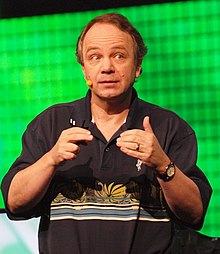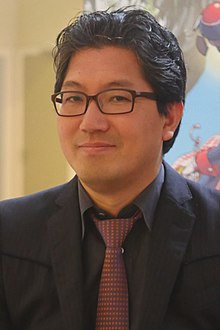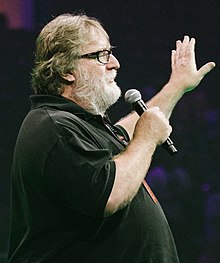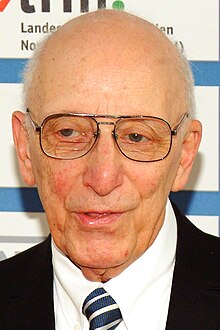The Video Games Portal

A video game or computer game is an electronic game that involves interaction with a user interface or input device (such as a joystick, controller, keyboard, or motion sensing device) to generate visual feedback from a display device, most commonly shown in a video format on a television set, computer monitor, flat-panel display or touchscreen on handheld devices, or a virtual reality headset. Most modern video games are audiovisual, with audio complement delivered through speakers or headphones, and sometimes also with other types of sensory feedback (e.g., haptic technology that provides tactile sensations). Some video games also allow microphone and webcam inputs for in-game chatting and livestreaming.
Video games are typically categorized according to their hardware platform, which traditionally includes arcade video games, console games, and computer (PC) games; the latter also encompasses LAN games, online games, and browser games. More recently, the video game industry has expanded onto mobile gaming through mobile devices (such as smartphones and tablet computers), virtual and augmented reality systems, and remote cloud gaming. Video games are also classified into a wide range of genres based on their style of gameplay and target audience. (Full article...)
Featured articles –
Jill is the protagonist of several Resident Evil games, novelizations, films, and has also appeared in other game franchises including Marvel vs. Capcom, Project X Zone, Teppen, and Dead by Daylight. In later games, such as the 2002 Resident Evil remake, The Umbrella Chronicles (2007), Resident Evil 5 (2009), and The Mercenaries 3D (2011), her features were based on Canadian model and actress Julia Voth. Several actresses have portrayed Jill, including Sienna Guillory and Hannah John-Kamen in the live-action Resident Evil films.
Video game publications described Jill as among the most popular and iconic video game characters, and praised her as the most likable and consistent Resident Evil character. She has received both acclaim and criticism with regard to gender representation in video games. Several publications praised the series for its portrayal of women and considered Jill significantly less sexualized than other female game characters; she was also cited as an example of a female character who was as competent and skilled as her male counterparts. Others argued she was weakened as a protagonist by attributes that undermined her role as a heroine, specifically an unrealistic body shape that did not reflect her military background; some of her overtly sexualized costumes have also been criticized. (Full article...)
Each game has the player assume the role of a taxi driver who must accumulate money by delivering passengers to their destinations in the fastest time possible, earning tips by performing "crazy stunts" before the time runs out. The franchise has been recognized for its innovative gameplay design which is easy to learn but difficult to master, its use of in-game advertising, and its soundtrack music provided by the bands The Offspring and Bad Religion. The core gameplay mechanic was patented by Sega, leading to at least one lawsuit over similar gameplay in The Simpsons: Road Rage, which was settled out of court. (Full article...)
Rather than using a turn-based battle system like contemporaneous role-playing games, Secret of Mana features real-time battles with a power bar mechanic. The game has a unique Ring Command menu system, which pauses the action and allows the player to make decisions in the middle of battle. An innovative cooperative multiplayer system allows a second or third player to drop in and out of the game at any time. Secret of Mana was directed and designed by Koichi Ishii, programmed primarily by Nasir Gebelli, and produced by veteran Square designer Hiromichi Tanaka.
The game received acclaim for its brightly colored graphics, expansive plot, Ring Command menu system, and innovative real-time battle system. Critics also praised Hiroki Kikuta's soundtrack and the customizable artificial intelligence (AI) settings for computer-controlled allies. Retrospectively, it has been considered one of the greatest games of all time by critics. (Full article...)
Development of Riven began soon after Myst became a success, and spanned more than three years. In an effort to create a visual style distinct from that of Myst, director Robyn Miller and his brother, producer Rand Miller recruited former Aladdin production designer Richard Vander Wende as a co-director. Broderbund employed a multimillion-dollar advertising campaign to publicize the game's release.
Riven was praised by reviewers, with the magazine Salon proclaiming that the game approaches the level of art. Critics positively noted the puzzles and immersive experience of the gameplay, though publications such as Edge felt that the nature of point-and-click gameplay limited the title heavily. The best-selling game of 1997, Riven sold 1.5 million copies in one year. After the game's release, Robyn Miller left Cyan to form his own development studio, ending the professional partnership of the two brothers. Rand stayed at Cyan and continued to work on Myst-related products including The Myst Reader and the real-time rendered game Uru: Ages Beyond Myst. The next entry in the Myst series, Myst III: Exile, was developed by Presto Studios and published by Ubisoft. A remake of the game is in development. (Full article...)
Underground is built upon the skateboarding formula of previous Tony Hawk's games: the player explores levels and completes goals while performing tricks. The game features a new focus on customization; the player, instead of selecting a professional skater, creates a custom character. Underground adds the ability for players to dismount their boards and explore on foot. The plot follows the player character and their friend Eric Sparrow as the two become professionals and grow apart.
The game was developed with a theme of individuality which was manifested in the extensive character customization options, the presence of a narrative, and the product's characterization as an adventure game. Real world professional skateboarders contributed their experiences to the plot. Upon release, the game was a major critical and commercial success, with reviewers praising its wide appeal, soundtrack, customization, multiplayer, and storyline. The graphics and the controls for driving vehicles and walking were less well received. Underground's PlayStation 2 version had sold 2.11 million copies in the United States by December 2007. A sequel, Tony Hawk's Underground 2, followed in 2004. (Full article...)
Designed by an R&D team supervised by Hideki Sato and Masami Ishikawa, the Genesis was adapted from Sega's System 16 arcade board, centered on a Motorola 68000 processor as the CPU, a Zilog Z80 as a sound controller, and a video system supporting hardware sprites, tiles, and scrolling. It plays a library of more than 900 games on ROM-based cartridges. Several add-ons were released, including a Power Base Converter to play Master System games. It was released in several different versions, some created by third parties. Sega created two network services to support the Genesis: Sega Meganet and Sega Channel.
In Japan, the Mega Drive fared poorly against its two main competitors, Nintendo's Super Famicom and NEC's PC Engine, but it achieved considerable success in North America, Brazil, and Europe. Contributing to its success was its library of arcade game ports, the popularity of Sega's Sonic the Hedgehog series, several popular sports franchises, and aggressive youth marketing that positioned it as the cool console for adolescents. The 1991 North American release of the Super Nintendo Entertainment System triggered a fierce battle for market share in the United States and Europe known as the "console war". This drew attention to the video game industry, and the Genesis and several of its games attracted legal scrutiny on matters involving reverse engineering and video game violence. Controversy surrounding violent games such as Night Trap and Mortal Kombat led Sega to create the Videogame Rating Council, a predecessor to the Entertainment Software Rating Board. (Full article...)
Did you know... -
- ... that a cheat code for the 2003 video game Hulk is hidden in a scene of the film it is based on?
- ... that the 2014 text adventure The Uncle Who Works for Nintendo is inspired by a source cited by children for spreading video game rumors?
- ... that classified documents of the United States were partially leaked onto a Discord server for the video game Minecraft?
- ... that Through the Darkest of Times was the first video game published in Germany to use swastikas?
- ... that the European version of the video game Tomba! uses the theme song of the television series No Sweat as its opening theme?
- ... that the Chicago Sun-Times credits JumpStart Toddlers as the first video game targeted towards babies?
- ... that Splatoon 3 became the fastest-selling video game of all time in Japan three days after launch?
- ... that the urban legend Herobrine was ranked on a Guinness World Records poll of the best video game villains, despite never existing?
- ... that the case Lewis Galoob Toys, Inc. v. Nintendo of America, Inc. was considered essential to the future of video game modding in the United States in 1992?
- ... that the game designer of the video game Hades said that the characters were attractive "because Jen Zee"?
- ... that Kamibox's video game A Joke That's Worth $0.99 is permanently on special offer because Itch.io does not allow $0.99 as a regular price?
- ... that the leak of the upcoming Grand Theft Auto game was described as one of the biggest leaks in video game history?
Selected biography –
Selected image -
- April 16, 2024 – 2023–2024 video game industry layoffs
- American video game company Take-Two Interactive lays off 5% of its workforce. (Reuters)
- April 10, 2024 – 2023–2024 video game industry layoffs
- American video game company Epic Games announces that it will lay-off around 870 employees, roughly one-sixth of its workforce, due to slower growth than expected. (CBC via Yahoo! News)
- December 22, 2023 –
- China passes a series of regulations aimed at limiting video game microtransactions. The new rules include banning rewards for logging on for multiple consecutive days and banning rewards for players if they spend money in a game for the first time. (Reuters)
Topics
Categories
Things you can do
In other Wikimedia projects
The following Wikimedia Foundation sister projects provide more on this subject:
-
Commons
Free media repository -
Wikibooks
Free textbooks and manuals -
Wikidata
Free knowledge base -
Wikinews
Free-content news -
Wikiquote
Collection of quotations -
Wikisource
Free-content library -
Wikiversity
Free learning tools -
Wiktionary
Dictionary and thesaurus













































